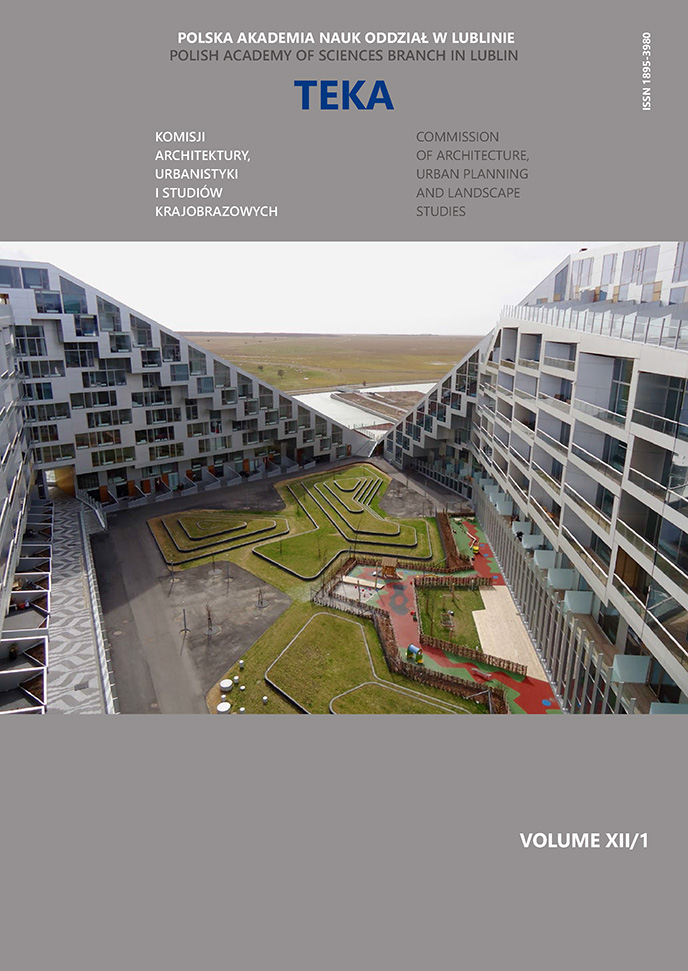Natural ventilation and thermal comfort in public buildings
Article Sidebar
Open full text
Issue Vol. 12 No. 1 (2016)
-
The impact of Unite d’Habitation on the formation of Superjednostka in Katowice
Joanna Kania7-15
-
Historic alleys of Podlasie region – Droblin, Leśna Podlaska commune
Wojciech Durlak, Margot Dudkiewicz, Mariusz Szmagara16-21
-
Disability vs spatial planning and landscaping – selected examples
Paweł Szumigała, Piotr Urbański22-28
-
Natural ventilation and thermal comfort in public buildings
Joanna Pieczara29-39
-
Issues of adapting design solutions to the needs of seniors and people with disabilities in teaching urban design
Marzena Joanna Siestrzewitowska40-48
-
Multi-criterion comparative analysis – tool for the functional quality assessment of flats
Part I. The base of conducted examinationsWalery Jezierski, Maciej Kłopotowski, Anna Gromadzka49-58 -
Complexity of city structure in reference to Barcelona
Wojciech Kocki, Bartłomiej Kwiatkowski59-64
-
Role of imagination in a creativity process and a threats of the modern world
Mariusz Dąbrowski, Agnieszka Chęć-Małyszek65-80
Archives
-
Vol. 16 No. 4
2020-12-30 11
-
Vol. 16 No. 3
2020-09-30 10
-
Vol. 16 No. 2
2020-06-30 11
-
Vol. 16 No. 1
2020-03-31 10
-
Vol. 14 No. 3
2018-10-28 14
-
Vol. 14 No. 2
2018-06-29 14
-
Vol. 14 No. 1
2018-03-30 13
-
Vol. 13 No. 4
2017-12-29 8
-
Vol. 13 No. 3
2017-09-29 9
-
Vol. 13 No. 2
2017-06-30 10
-
Vol. 13 No. 1
2017-03-31 10
-
Vol. 12 No. 4
2016-12-30 12
-
Vol. 12 No. 3
2016-09-30 10
-
Vol. 12 No. 2
2016-06-30 9
-
Vol. 12 No. 1
2016-03-31 8
-
Vol. 11 No. 4
2015-12-30 14
-
Vol. 11 No. 3
2015-09-30 7
-
Vol. 11 No. 2
2015-06-30 8
-
Vol. 11 No. 1
2015-03-31 11
Main Article Content
DOI
Authors
Abstract
Indoor air quality and building’s thermal comfort depend very much on a ventilation system. At the same time they have an influence on health and well- being of users of buildings. The users prefer the natural ventilated spaces. The running costs of naturally ventilated buildings are smaller than the running costs of mechanically ventilated buildings. However, the construction costs of the naturally ventilated buildings could be bigger. Public buildings could be ventilated naturally,
but the natural ventilation has its limits. The main rule for designing the natural ventilated spaces is to minimize the heats gains and indoor air pollution, and to expose the hygroscopic building’s components and the components with the high thermal capacity.
The temperature and the other air quality components would be more variable in naturally ventilated buildings than in air conditioned buildings. This is the reason, why the natural ventilation rather cannot be used in the buildings and the buildings parts, where the indoor climate parameters have to be constant. The thermal comfort in the naturally ventilated buildings should be assessed by the adaptive comfort model. The adaptive comfort model, relates indoor climate parameters to the outdoor conditions, and take into account the adaptation capacity of the users. The ventilation systems in the buildings located in moderate climates has to work at least in three scenarios: spring-autumn, winter and summer. The natural ventilation systems the best work in spring-autumn scenario. Winter scenario has to take into account the heat losses caused by the intake air. In summer, it could be difficult to maintain the continuity of the natural ventilation and to preserve the building from overheating. The night cooling could be used in periods of the occurring of the high outside temperatures. The effectiveness of the night cooling depends on the limitation of the heat loads, the building’s thermal mass and the night air temperature.
The natural ventilation systems require integrated planning. From the very beginning, architects, structure engineers, HVAC designers and the other specialists should work together on the design of the naturally ventilated building. This requirement, the limitations of the natural ventilation and the higher construction costs are the reasons why investors oft prefer the air condition or mixed mode systems.
Keywords:
References
Passe U., Battaglia F. Designing Spaces for Natural Ventilation An Architect’s Guide, Taylor &Francis, New York 2015. DOI: https://doi.org/10.4324/9780203583470
Hegger, Fuchs, Stark, Zeumer, Energy Manual – Sustanable Architecture, Birkhauser Verlag AG, Basel, Boston, Berlin 2008. DOI: https://doi.org/10.11129/detail.9783034614542
Wood A., Salib R., Natural Ventilation in High-Rise Office Buildings, CTBUH Technical Guide, Routledge, New York, London 2013. DOI: https://doi.org/10.4324/9780203720042
Halliday S., Sustainable Construction, Butterworth-Heinenmann, Oxford Haselbach L 2008. DOI: https://doi.org/10.4324/9780080557168
Natural ventilation in non-domestic building CIBSE Application Manual AM10, The Charted Institution of Building Services Engineers, London 2005.
https://www.iea.org/publications/freepublications/publication/TechnologyRoadmapEnergyEfficientBuildingEnvelopes.pdf z dn.21.02.2015.
Environmental design CISBE Guide A, The Chartered Institution of Building Services Engine-ers, London 2015
Rozporządzenie Ministra Infrastruktury w sprawie warunków technicznych, jakim powinny odpowiadać budynki i ich usytuowanie z dnia 12 kwietnia 2002 r. (Dz.U. Nr 75, poz. 690)
http://www.energieagentur.nrw/lueftung dostęp z dn. 25.02.2015.
https://en.wikipedia.org/wiki/Commerzbank_Tower dostęp z dn.06.04.2016.
http://cmiserver.mit.edu/natvent/Europe/commerzbank.htm dostęp z dn.06.04.20116.
http://www.cibsejournal.com/case-studies/leading-man/ dostęp z dn.03.10.2016.
http://www.haworthtompkins.com/built/proj44/index.html dostęp z dn.07.10.2016.
Article Details
Abstract views: 214


